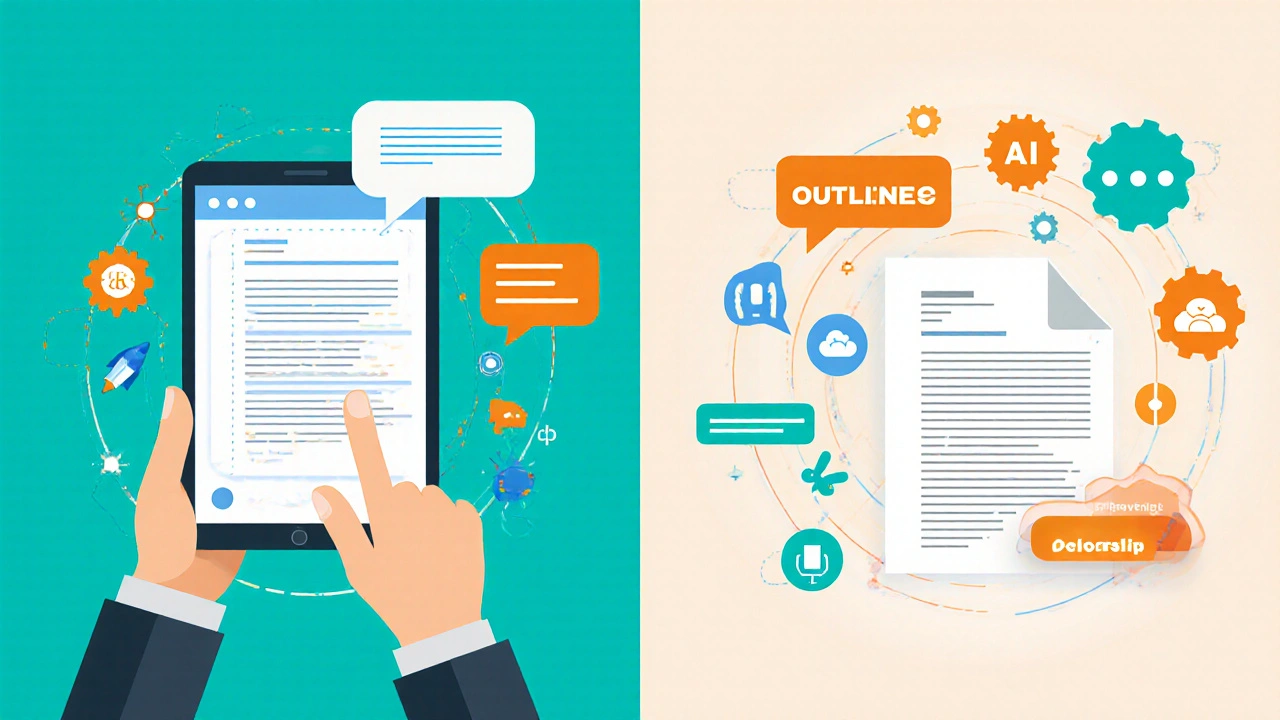Content Creation Time & Cost Calculator
Your Current Workflow
ChatGPT Workflow
Typical ChatGPT workflow takes 4-5 minutes per article (based on article data)
Ever felt stuck staring at a blank screen while a deadline looms? You’re not alone. Marketers, bloggers, and small business owners all face the same pressure to churn out fresh, engaging copy day after day. What if a single tool could cut the brainstorming time in half, keep your brand voice consistent, and even boost SEO without hiring a full‑time writer? That’s where ChatGPT steps in. In this guide we’ll unpack why the AI chatbot is becoming the secret weapon for modern content teams and how you can weave it into a seamless creation workflow.
What Exactly Is ChatGPT?
ChatGPT is a conversational AI model developed by OpenAI. Built on the GPT‑4 architecture, it predicts text one token at a time, allowing it to generate human‑like responses to prompts. In plain English, give it an instruction or a few keywords, and it drafts paragraphs, headlines, scripts, or even data‑driven reports. Since its public launch in 2022, it’s been adopted by creators across blogs, newsletters, ads, and video scripts.
Why ChatGPT Matters for Content Creation
Speed is the headline. A typical writer might take 30-45 minutes to outline and draft a 500‑word blog post. ChatGPT can spin out a first draft in under five minutes, giving you more time for research and polishing. But speed isn’t the only advantage.
- Idea generation: Stuck on topics? Ask it to brainstorm niche angles, list trending keywords, or suggest hook sentences.
- Consistency: Feed it a style guide and it will mimic your brand voice across dozens of pieces, reducing the back‑and‑forth with editors.
- SEO alignment: Instruct it to incorporate target keywords naturally, generate meta descriptions, and even suggest internal link structures.
- Multilingual support: Need a quick translation or a culturally adapted version? The model handles over 20 languages with decent fluency.
All these benefits translate into higher output without sacrificing quality-exactly what fast‑moving digital‑marketing teams crave.
Prompt Engineering: The Skill That Unlocks Value
The magic of ChatGPT lives in the prompt you give it. Prompt engineering is the practice of crafting clear, specific instructions that guide the model toward the desired output. Think of it as a conversation with a junior writer: the clearer you are, the better the result.
Here are three quick formulas you can adopt:
- Role + Task + Constraints: "You are a veteran copywriter. Write a 150‑word LinkedIn post about sustainable fashion, using a friendly tone and three bullet points."
- Example First: Provide a short sample and ask for a variation: "Here’s a headline: ‘Boost Your ROI with AI‑Powered Ads.’ Write three alternatives in the same style."
- Iterative Refinement: Start broad, then narrow: "Draft an intro for a fintech blog. Now add a statistic about mobile payments in Australia."
Experimenting with these structures helps you get consistent, on‑brand copy faster.

Integrating ChatGPT Into Your Content Workflow
Imagine a typical week for a content marketer. Monday: brainstorm topics, Tuesday: outline, Wednesday: write, Thursday: edit, Friday: publish. With ChatGPT, you can collapse several of those steps.
Here’s a practical workflow you can adopt:
- Research & Ideation: Use tools like AnswerThePublic or Google Trends, then ask ChatGPT to synthesize the data into a list of article angles.
- Outline Generation: Prompt: "Create a detailed outline for a 1,200‑word guide on ‘AI in email marketing’ with H2 headings and key bullet points for each section."
- First Draft: Feed the outline back and request a full draft, specifying tone (e.g., conversational, professional) and word count.
- SEO Optimization: Instruct the model: "Add the keyword ‘AI email automation’ three times, include a meta description under 160 characters, and suggest three internal links."
- Human Review: A quick read‑through to verify facts, tweak brand nuances, and ensure compliance with any AI ethics guidelines.
- Publish & Track: Upload to your CMS, schedule social shares, and monitor performance metrics like dwell time and click‑through rate.
This loop can shrink a week‑long production schedule down to a couple of days, freeing up bandwidth for strategy work.
ChatGPT vs. Traditional Copywriting Tools
| Feature | ChatGPT | Traditional Tools (e.g., Jasper, MarketMuse) |
|---|---|---|
| Cost per month | Starts at $20 (ChatGPT Plus) | $50‑$100+ |
| Response time | Instant (seconds) | Seconds‑minutes |
| Customization | Prompt‑based, API fine‑tuning | Template‑driven, limited flexibility |
| Language support | 20+ languages, near‑native fluency | 5‑10 languages, variable quality |
| Scalability | Handles bulk requests via API | Often limited by seat licenses |
While niche tools excel at specific SEO suggestions, ChatGPT offers broader versatility, lower cost, and a faster turnaround-making it a better fit for teams that need to produce diverse content types.

Best Practices for High‑Quality AI‑Generated Content
Even the smartest model can produce off‑beam copy if left unchecked. Follow these guardrails to keep output sharp:
- Fact‑check everything: The model can hallucinate statistics. Use reputable sources like Statista or government databases.
- Maintain brand tone sheets: Store key adjectives, banned words, and style examples; feed them into each prompt.
- Leverage NLP for tone analysis: Run the draft through sentiment tools (e.g., IBM Watson Tone Analyzer) to confirm the emotional vibe matches your goal.
- Optimize for SEO, not keyword stuffing: Ask for natural inclusion of primary and LSI terms, and request a readable H‑tag hierarchy.
- Stay ethical: Disclose AI assistance where relevant, and avoid using the model for disallowed content such as deep‑fakes or misinformation.
These steps turn a raw AI draft into a polished piece ready for publishing.
Measuring ROI: How to Prove ChatGPT’s Value
Investments need proof. Track these KPIs to see the impact of AI‑assisted writing:
- Content volume per week - compare the number of published assets before and after adoption.
- Production time - record hours saved per article; many teams report 50‑70% reductions.
- Engagement metrics - monitor bounce rate, average time on page, and social shares to ensure quality stays high.
- SEO performance - watch keyword rankings and organic traffic growth; AI‑optimized copy often climbs faster.
- Cost efficiency - calculate saved labor costs versus subscription fees for ChatGPT Plus or API usage.
When the numbers tilt positively, you have a clear case for expanding AI use across more channels.
Common Pitfalls and How to Avoid Them
Even seasoned marketers trip up with AI. Here are the most frequent mistakes and quick fixes:
- Over‑reliance on one prompt style: Keep a Prompt Library. Mix role‑based, example‑first, and iterative prompts to prevent repetitive phrasing.
- Ignoring plagiarism checks: Run drafts through tools like Copyscape to ensure originality, especially when re‑using source material.
- Neglecting human voice: Add a personal anecdote or brand story after the AI draft. This gives readers a genuine touch.
- Skipping the edit loop: Treat AI output as a first draft, not the final copy. A 5‑minute edit can catch tone missteps and factual errors.
- Under‑estimating data privacy: When feeding proprietary info into prompts, use the OpenAI API with enterprise data controls to keep sensitive content safe.
Address these early, and the tool becomes a reliable teammate rather than a risky shortcut.
Can ChatGPT replace human writers completely?
No. ChatGPT excels at generating drafts, brainstorming ideas, and handling repetitive tasks, but it lacks deep industry expertise, brand storytelling nuance, and critical judgment. The best results come from a hybrid approach where AI handles the heavy lifting and humans add strategic polish.
How do I keep ChatGPT outputs consistent with my brand voice?
Create a concise style guide (tone, preferred words, prohibited phrases) and feed it into every prompt. You can also supply a short sample paragraph written in your brand voice as a reference for the model.
Is the content generated by ChatGPT SEO‑friendly out of the box?
It can be, if you ask for it. Include instructions to use target keywords, suggest meta tags, and ask for a logical heading structure. Always run the final draft through an SEO audit tool to fine‑tune readability and keyword density.
What are the costs of using ChatGPT for a small business?
ChatGPT Plus costs $20 per month and offers faster response times. If you need higher volume, the API pricing starts at $0.002 per 1,000 tokens, which translates to a few dollars for dozens of blog posts. It’s usually cheaper than hiring a freelance writer for the same output.
How can I ensure the information generated is accurate?
Treat the AI output as a starting point. Verify any statistics, quotes, or legal statements with reputable sources before publishing. Using a fact‑checking workflow saves reputation risks.




Write a comment